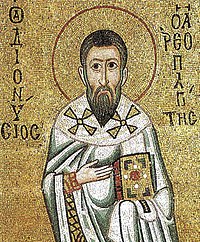Dionysius the Areopagite (/daɪəˈnɪsiəs/; Greek: Διονύσιος ὁ Ἀρεοπαγίτης Dionysios ho Areopagitēs) was an Athenian judge at the Areopagus Court in Athens, who lived in the first century. A convert to Christianity, he is venerated as a saint by multiple denominations.
Dionysius the Areopagite | |
|---|---|
 Mosaic of Dionysius in Hosios Loukas monastery | |
| Hieromartyr and Bishop of Athens | |
| Born | 1st century AD |
| Died | 1st century AD |
| Venerated in | |
| Feast |
|
| Attributes | Vested as a bishop, holding a Gospel Book |
| Patronage | Athens, Crotone, Jerez de la Frontera and Ojén |
Life
editAs related in the Acts of the Apostles (Acts 17:34), he was converted to Christianity by the preaching of Paul the Apostle:[2]
Howbeit certain men clave unto him, and believed: among the which was Dionysius the Areopagite, and a woman named Damaris, and others with them.
After his conversion, Dionysius became the first Bishop of Athens,[3] though he is sometimes counted as the second after Hierotheus. He is venerated as a saint in the Catholic and the Eastern Orthodox churches. He is the patron saint of Athens and is venerated as the protector of judges and the judiciary. His memory is celebrated on October 3.[4]
Historic confusions
editIn the early sixth century the so-called Corpus Dionysiacum, a series of writings of a mystical nature, employing Neoplatonic language to elucidate Christian theological and mystical ideas, was ascribed to the Areopagite. Its author is now known as Pseudo-Dionysius the Areopagite.[5] A minority of scholars, including Romanian theologian Dumitru Stăniloae,[6] argue in favor of authenticity citing internal historical details and the existence of explicit citations of Dionysius predating Proclus by writers such as Dionysius of Alexandria and Gregory Nazianzus.[7] Even Proclus himself appears to cite an external authority for a euphemism ("flowers and supersubstantial lights") when the said verbiage is found explicitly in the Corpus Dionysiacum.[8]
Dionysius has been misidentified with the martyr Dionysius, the first Bishop of Paris. However, this mistake by a ninth-century writer is ignored and each saint is commemorated on his respective day.[9]
Modern references
editIn Athens there are two large churches bearing his name, one in Kolonaki on Skoufa Street, while the other is the Catholic Metropolis of Athens, on Panepistimiou Street. The pedestrian walkway around the Acropolis, which passes through the rock of the Areios Pagos, also bears his name.
Dionysius is the patron saint of the Gargaliani of Messenia, as well as in the village of Dionysi in the south of the prefecture of Heraklion. The village was named after him and is the only village of Crete with a church in honor of Saint Dionysios Areopagitis.
See also
edit- St. Dionysus Institute in Paris
- Early centers of Christianity#Greece
- Cathedral Basilica of St. Dionysius the Areopagite (A Roman Catholic church in Athens named after Dionysius the Areopagite)
- St Dionysius' Church, Market Harborough, UK
Further reading
edit- Ælfric of Eynsham (1881). . Ælfric's Lives of Saints. London, Pub. for the Early English text society, by N. Trübner & co.
- Chapman, Henry Palmer (1909). . In Herbermann, Charles (ed.). Catholic Encyclopedia. Vol. 5. New York: Robert Appleton Company.
- Alexander Weiß, Soziale Elite und Christentum. Studien zu ordo-Angehörigen unter den frühen Christen, Berlin/Boston, De Gruyter, 2015, pp. 80–101.
References
edit- ^ Domar: The calendrical and liturgical cycle of the Armenian Apostolic Orthodox Church, Armenian Orthodox Theological Research Institute, 2002, p. 528.
- ^ "Dionysius The Areopagite". Encyclopedia Britannica.
- ^ Eusebius, Historia Ecclesiae III: iv
- ^ "Dionysios the Areopagite - Greek Orthodox Archdiocese of America". www.goarch.org. Retrieved 2018-10-04. Martyrologium Romanum, editio typica altera (Vatican City: Typis Vaticanis, 2004).
- ^ Stanford Encyclopedia of Philosophy on the confusion between Dionysius and Pseudo-Dionysius
- ^ "The Dionysian Authorship of the "Corpus Areopagiticum" According to Fr. Dumitru Staniloae". johnsanidopoulos.com. Retrieved 2023-12-06.
- ^ Anthony Pavoni and Evangelos Nikitopoulos, The Life of Saint Dionysius the Areopogite. Scriptorium Press: Montreal, 2023, 14–180.
- ^ Anthony Pavoni and Evangelos Nikitopoulos, The Life of Saint Dionysius the Areopogite. Scriptorium Press: Montreal, 2023, 94–96.
- ^ "Hieromartyr Dionysius of Paris, Bishop". oca.org. Retrieved 2015-10-16.
Sources
edit- Corrigan, Kevin; Harrington, Michael. "Pseudo-Dionysius the Areopagite". In Zalta, Edward N. (ed.). Stanford Encyclopedia of Philosophy.
External links
edit- Works by or about Dionysius the Areopagite at Wikisource
- Hieromartyr Dionysius the Areopagite the Bishop of Athens Orthodox icon and synaxarion
- Max Müller Dionysius the Areopagite Lecture 1895